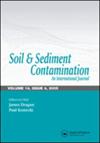土壤中铬(VI)的传统与创新处理方法
IF 1.5
4区 环境科学与生态学
Q4 ENVIRONMENTAL SCIENCES
引用次数: 43
摘要
有几种处理技术可用于铬含量升高的土壤。适用于特定铬场地的技术取决于清理目标、存在的铬的形式以及含铬土壤的体积和物理化学性质。在许多情况下,清理目标是基于土壤中的铬(VI)浓度。因此,大多数可用的处理技术包括(1)从现场去除含Cr(VI)的土壤,(2)固定铬,使其在现场条件下处理后不会浸出,或(3)将土壤中的Cr(VI)降低到Cr(III)状态。本文讨论了每种修复策略可用的处理技术,它们的优点和缺点,以及它们的相对处理成本。评估的技术包括挖掘和场外处理,土壤洗涤,土壤冲洗,电动,固化/稳定,玻璃化,化学和生物…本文章由计算机程序翻译,如有差异,请以英文原文为准。
Traditional and innovative treatment methods for Cr(VI) in soil
There are several treatment technologies available for soils that have elevated levels of chromium. The technologies applicable to a particular chromium site depend on the clean‐up goals, the form of the chromium present, and the volume and physical chemical properties of the chromium‐containing soils. In many cases the clean‐up goals are based on the Cr(VI) concentration in the soils. Therefore, most of the available treatment technologies consist of (1) removing the Cr(VI)‐containing soils from the site, (2) immobilizing the chromium so that it will not leach after treatment under field conditions, or (3) reducing the Cr(VI) in the soils to the Cr(III) state. This article discusses the treatment technologies available for each of these remediation strategies, their advantages and disadvantages, and their relative treatment costs. Technologies evaluated include excavation and off‐site disposal, soil washing, soil flushing, electrokinetics, solidification/stabilization, vitrification, and chemical and bio...
求助全文
通过发布文献求助,成功后即可免费获取论文全文。
去求助
来源期刊

Soil & Sediment Contamination
环境科学-环境科学
CiteScore
4.20
自引率
10.00%
发文量
53
审稿时长
2.2 months
期刊介绍:
When it comes to assessing and mitigating contaminated soils and sediments, there is no substitute for having the very latest tools, techniques and methodologies at your fingertips to help you deal with these issues efficiently and cost-effectively.
This is just the kind of essential expertise you’ll only find in Soil and Sediment Contamination . This internationally, peer-reviewed publication focuses on soil and sediment contamination from:
-Sludges-
Petroleum-
Petrochemicals-
Chlorinated hydrocarbons-
Pesticides-
Lead and other heavy metals.
Get detailed descriptions of all the latest and most efficient offsite and in situ remediation techniques, strategies for assessing health effects and hazards, and tips for dealing with everyday regulatory and legal issues. With the state-of-the-art tools that Soil and Sediment Contamination provides, you can successfully assess, mitigate, and solve both rural and urban soil contamination problems as efficiently and economically as possible.
 求助内容:
求助内容: 应助结果提醒方式:
应助结果提醒方式:


